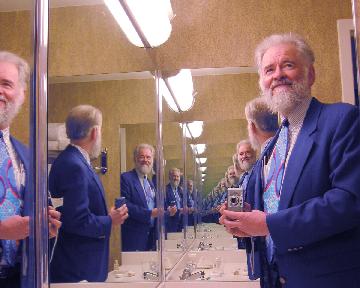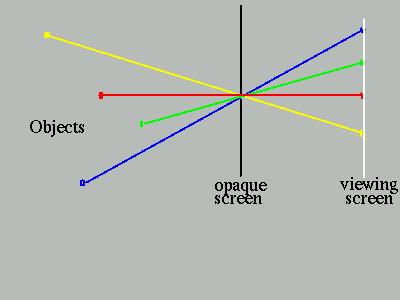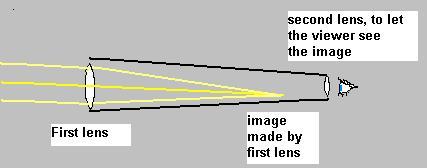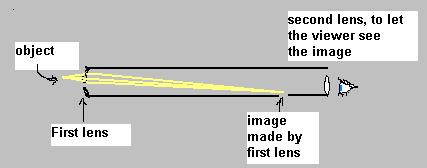
We see not only our image, but
the images of images!

|
| Parallel mirrors are fun! We see not only our image, but the images of images! |
|---|
When you look in a mirror, you seem to see someone who looks just like you. All the light that left your nose is reflected by the mirror in such a way that it now seems to be coming from a particular place behind the mirror. The mirror-person is an example of an image.
When we look through a lens, we are modifying the properties
of the lens of our eye. Since this is already somewhat adjustable,
we can use a variety of lenses and use them in many ways -- near
the eye or far away -- and still get a useful effect.
However, when we are making an image on a screen, now everything
has to be right. All the light beams from any part of the light source must
come together again at the screen, or we get an image that is
out of focus.
So if we want to use a lens to make an image, we had better understand
how to do it.

Accidental images do occur: a door slightly cracked open to
let light from outside enter a dim hall will produce a pattern
representing the scene outside.
This is a version of a kind of camera called a
pinhole camera.
For this to work well, the hole needs to be small, and then the
light is dim. Putting in a lens lets the hole be bigger; but
the basic element that the lights that are high give images
that are low is not changed.
Optical instruments such as microscopes and telescopes use
several lenses. At the heart of each is the principle of
the magnifier, that we can get our eye close to something
and thus see a "magnified" view if we use a strong lens.
However, in a microscope or telescope, what is being viewed
is itself an image:

A diagram of a telescope. The object being viewed is far
to the right, and the light coming from it is almost parallel.
The first lens makes an image inside the telescope. The image
will be bigger if the focal length of the lens is larger --
so high-power telescopes tend to be pretty long! This image will
look still bigger if we look at it up close, using a magnifying
lens, and so the second lens is very strong.
This kind of telescope gives an upside down image. People
used to learn how to make sense of upside down ships on the horizon!
Modern telescopes and binoculars are a little more complicated that
this, to turn the image back over.

A diagram of a microscope. The object being viewed is close
to the first lens.
This gives a greatly magnified image, and we
magnify this still more with the second lens.
For an actual microscope the first lens is smaller and has
a very short focal length (that is, it is a really strong lens);
the object is place very close to
the lens, so that its image is relatively far away, down near
the second lens.
The unit on images